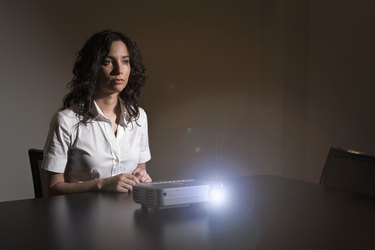
Computer projectors are incredibly popular these days. Whether used for showing PowerPoint presentations and business reports during meetings, or movies at a party, projectors add value and convenience to many businesses and homes. Any modern Windows computer can connect to a projector, and the Windows 7 operating system makes set-up a breeze. Before beginning, make sure you have the correct video cable for your device, and dim any lighting in the vicinity of the projector screen to increase visibility.
Step 1
Plug one end of a video cable -- the plug will either be a blue VGA plug or a white DVI, depending on the projector -- into the laptop's video port.
Video of the Day
Step 2
Plug the other end into the projector's "video in" port. Again, the port will either be blue (VGA) or white (DVI).
Step 3
Turn on the computer and the projector. The projector may need a minute or two to warm up.
Step 4
Click "Start," and then type "projector" (without the quotation marks) in the search box. Or, press the Windows key and "P," and skip to Step 6. A similar shortcut involves pressing and holding the "Function" (FN) key and your external display function key, which would probably be among the top row of keys. It may have a monitor icon or "LCD/CRT" printed on it.
Step 5
Click "Connect to a projector" when it appears in the list.
Step 6
Click on the display option you want.
Choosing "Duplicate" will project the image onto your projector screen, while also displaying it on the laptop screen. "Extend" allows you to use the projector screen and your laptop in a dual-display configuration. This means that both the laptop and projector screens will combine into one huge display; while "Projector only" will shut off your laptop screen and enable viewing on the projector screen only.
Video of the Day